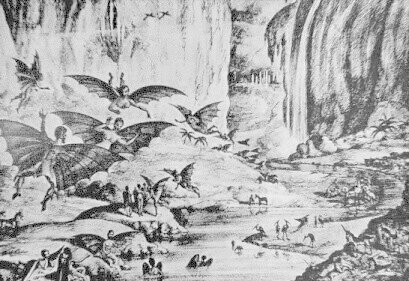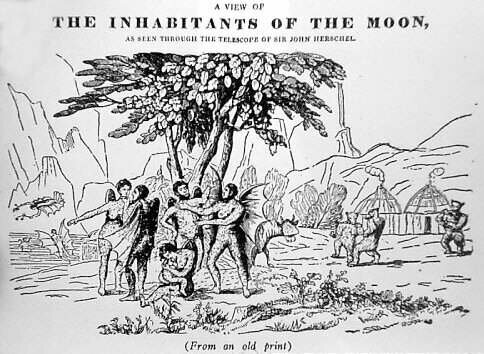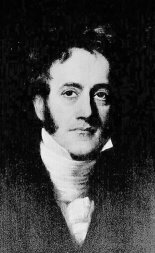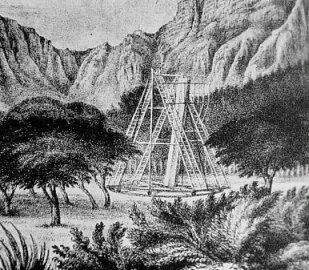|
THE MOON HOAX
by Donald E. SimanekSir William Herschel (1738-1822) was a first rate astronomer. He and his sister Caroline catalogued star clusters and nebulae, discovering new satellites of Saturn, and they also discovered the planet Uranus.
But Herschel was prone to speculate beyond the facts, and he was convinced by a shaky argument from analogy, that all stars and planets have intelligent life. In his own words, "they are well supplied with inhabitants." He even went so far as to conclude that our sun is inhabited, that the hot surface we observe is only a thin shell around a cooler surface within which life could exist.
|
Herschel remained convinced of the existence of his "sun men" up to his death in 1822.
William Herschel's son, John, also became a respected astronomer. In the year 1835 John was in Feldhausen, South Africa, where he built a telescope to take advantage of the clearer air there and to see portions of the southern sky not visible at northern latitudes.
In this year the New York Sun newspaper published, in instalment form, an alleged reprint account of John Herschel's discoveries in South Africa. The articles cited as their source, the Edinburgh Journal of Science, which had in fact been defunct for some years.
|
The articles created a sensation, for they told of Herschel's discovery of life on the moon. They described in detail his invention of a special system which magnified so greatly that one could observe the moon's surface as if one were standing on it. (Negative considerations like limits of resolution and atmospheric turbulence weren't mentioned.)
As the installments unfolded, this marvelous telescope observed the moon's craters, amethyst crystals 90 feet high, rivers, vegetation and animals, curly-antletered antelope, goats, cranes, pelicans, bison with eye-flaps of skin to shield their eyes from the sun, and tailless beaver.
 |
|---|
| Moon men and other creatures. 1835 lithograph. [The Bettmann Archive] |
Finally, the series revealed the discovery of moon men. They were furry, winged men and women, resembling bats, and could fly. Herschel was quoted, describing these creatures in full detail.
This was one of the most famous newspaper hoaxes in history. It even fooled some scientists. Two scientists from Yale couldn't find the original Edinburgh Journal articles in the Yale library. So they traveled to New York to obtain them from the newspaper's office. They were told the articles were at the printers. A newspaper runner took another route to the printing plant and told the printer where to send them next. They were given the royal runaround all day, and went back to Yale disappointed and none the wiser.
John Herschel, still in South Africa, finally heard of the hoax by letter, and thought it amusing, saying, "It is too bad my real discoveries here won't be that exciting."
But after a while he began to complain, "I have been pestered from all quarters with that ridiculous hoax about the Moon—in English French Italian & German!"
 |
|---|
| Title page of pamphlet reprint, showing moon men and hut-dwelling bipedal beavers. |
This hoax fooled so many people that it is easy to lose sight of its original target. The whole story was written by Richard Adams Locke, aggressive editor of the Sun, which was then a young, four-page daily paper sold for a penny a copy. The target of his satire was Dr. Thomas Dick, a writer of popular scientific books. Dick had a style which combined some scientific fact with fantastic speculation, wild theory, and moral preaching. Dick's books about the moon assumed, without proof, that the moon was inhabited, and went on to discuss how we might send signals and communicate with those inhabitants. The physicist-mathematician Gauss made similar proposals.
Locke was satirizing such pompous theorizing and extravagant writing. He succeeded all too well, and had to admit to friends that he never imagined how many people would be taken in, and said that he was "the best self-hoaxed man" in the community.
The name Gotham, a nickname for New York City, derives from the name of a mythical "land of fools". New York City had a reputation in the 19th century as being a place where suckers were ripe for picking. Since then this tradition of gullibility has spread over the entire country, and is now centered somewhere in California.
To learn more about the Moon Hoax see:
- Alexander Boese's Museum of Hoaxes.
- The Moon Hoax of the New York Sun.
The first reference also has the complete text of the newspaper articles.
![]() Input and suggests are welcome. Use the email address to the right,
and indicate which page to which you are responding.
Input and suggests are welcome. Use the email address to the right,
and indicate which page to which you are responding.
Return to The Hoaxes page.
Return to Donald Simanek's front page.



